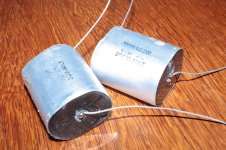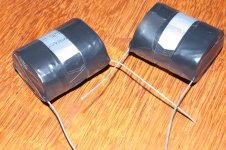Being a audio\music lover \ tech guy, I have bought many of the audio caps and have found the sound difference a worthwhile. But some are out of reach price wise to do much see if you like it testing. So knowing what makes a cap sound better or do a better job in a given app: power supply, x-over, signal path, by-pass , is of interest. going on what people say on the net is ok but most don't always have a good ear for upper hi-end audio.
Also if you know some of the ultra hi-end ones, Duelund, Jantzen, Mundorf
is there a justifiable reason for the high price. I have some of them and do enjoy the difference, so maybe that is the only reason needed. But as a tech I do like to know I am buying better product.
thanks
jjacks4x
As I stated before, this industry is extremely subjective. I do have a high-end audio set-up, but have never swapped components for a listening test.
I won't mention any names here, but some of the high-end capacitor suppliers (note the word supplier) are merely marking up someone else part. Or, perhaps having the part mfg to their standards, thus creating a middle man. Now if you send it to every "review" out there and get good press, and the price just went up.
There are always people that have more money than common sense, so they have no problem buying the pure silver foil teflon capacitors for hundreds of dollars.
I remember a few years ago while on a bike ride (non-motorized) we pulled over to a little store out in the country to rest and re-fill our water. I noticed this fancy Italian all carbon frame, total tricked out with $2500 wheels. There was group ahead of us, they were heading out. The owner of the bike was obviously a rookie and said the next part of the ride was too hard and when they return (out & back loop), she would catch up. Okay it you own a $12K bicycle,you ought to be able to ride it
I remember a few years ago while on a bike ride (non-motorized) we pulled over to a little store out in the country to rest and re-fill our water. I noticed this fancy Italian all carbon frame, total tricked out with $2500 wheels. There was group ahead of us, they were heading out. The owner of the bike was obviously a rookie and said the next part of the ride was too hard and when they return (out & back loop), she would catch up. Okay it you own a $12K bicycle,you ought to be able to ride it
Geez, not everyone can ride like Lance.
jeff
Geez, not everyone can ride like Lance.
jeff
I think her bike cost more than Lances
at 75% yield, they can only stay in business if they pass on the cost of their inefficiency to the poor unsuspecting consumers....
I would venture to say, the down & dirty off shore suppliers do pass off their junk to the unsuspected. There are many types of markets - each of these markets can withstand different levels of quality. We have experience in this area and because of that refuse to do business in a few countries.
Also, as I mentioned in one of my other posts - 75% was an emotional response
Dealing with many types of customers, some actually spell out what acceptable losses are. They know there will be losses.
It's VERY good for the forum members when "Industry Professionals" contribute..
yeah, cheap caps
Not down and dirty ones- they wouldn't ever be on my list for potential suppliers. Wima, Vishay, Sprague (back in the day), TRW (ditto), Panasonic, CDE, those sorts of companies would be.
What is your take on Mallory and Illinois for that matter?
No recent experience with Mallory (I used to use their CG electrolytics 30-40 years ago), but for chauvinistic reasons, I ought to like Illinois.
You should like Illinois Caps SY. I have tried them, great for the price, in many applications.
Capf even from the same lot manufactered are not share the same "DNK"
@ capman57
I do agree with Yours bold statement 1000%, in the recent past
I did stand by semiauto. cap. winding machine closely quite many times and test the samples right there until we found with the manufacturer the final workable solution.
It wasn't for audio but for the some other purpose in diff. field where a lot of variable vibrations were present even in a well damped circuit encl. but I was then learn the lesson about how the cap. need to be tamed to get job done.
May just adding my 2c to the discussion here.
I post in the other thread where I do some quick measurements of two cap. test samples just to show how caps parasitics were acting in a more wide frequency axis.
It is very handy to know the ''DNK'' of a chosen cap. for a particularly calcul. value as needed in particular application. How it's parasitics looks like at that specific situation-location within the circuit. If the caps parasitic parameters are in effect at the exact chosen value situation it my then also change the circuits stable operation or all other possible deviations from calculated or simulated might arise.
The graphs are self explainable ...
If the mouse is pointed over each image
there is arising the explanation of images meaning, very useful...
Link:
With my best regards,
Andreas
I do agree in part that many claims are not easily substantiated by science. That said, to pass off "all capacitors are created equal" is pretty naive.
There are many manufacturing techniques that can effect electrical and physical properties of film capacitors, combine that with material variations, and the iterations are endless.
We recently sold a range of capacitors to a well known company so that they could perform electrical evaluations, followed up by "sound" tests. I can't disclose the company or the findings as they are not public. I can tell you that all of these were the same value (tight tolerance +-2%) and results were staggering.
For example - take .22 uf capacitor used in a snubber circuit. I could manufacture 10 different parts with the exact same value (+-1%) and the electrical characteristics would be all over the spectrum.
Lets start with dielectrics - common dielectrics are polypropylene, polyester, paper, polycarbonate (obsolete), polystyrene (obsolete), PTFE, PEN, & PPS. Any of these can be combined with each other, then in different ratios within the same capacitor. This has an effect on insulation resistance, dissipation factor, equivalent series resistance and dielectric absorption.
The electrode also has an effect on the electrical characteristics - Metalized vs. foil, then the type of foil. Lets toss in the termination to the capacitor section itself, and the possible variations are mind boggling. Just for the heck of it, let start changing the diameter to length ratio and see what happens.
I would say not all capacitors are created equal. I didn't even mention different manufacturing techniques.
Cheers
@ capman57
I do agree with Yours bold statement 1000%, in the recent past
I did stand by semiauto. cap. winding machine closely quite many times and test the samples right there until we found with the manufacturer the final workable solution.
It wasn't for audio but for the some other purpose in diff. field where a lot of variable vibrations were present even in a well damped circuit encl. but I was then learn the lesson about how the cap. need to be tamed to get job done.
May just adding my 2c to the discussion here.
I post in the other thread where I do some quick measurements of two cap. test samples just to show how caps parasitics were acting in a more wide frequency axis.
It is very handy to know the ''DNK'' of a chosen cap. for a particularly calcul. value as needed in particular application. How it's parasitics looks like at that specific situation-location within the circuit. If the caps parasitic parameters are in effect at the exact chosen value situation it my then also change the circuits stable operation or all other possible deviations from calculated or simulated might arise.
The graphs are self explainable ...
If the mouse is pointed over each image
there is arising the explanation of images meaning, very useful...
Link:
With my best regards,
Andreas
What about tinfoil/polyprop capacitors. They don't seem to popular, but I use the all the time when I need some "reassuring" quality output capacitors. I guess its the weight that makes these attractive. I have never seen tinfoil capacitors being offered by the large resellers. I think only SCR produces them for audio related rebranders. Is there a specific (historical?) use for tinfoil capacitors? Does Tinfoil have properties that challenge metallized foils or the usual metal foil (aluminium)? Or am I being fooled...
- Status
- Not open for further replies.
- Home
- Member Areas
- The Lounge
- "Audio" grade capacitors


